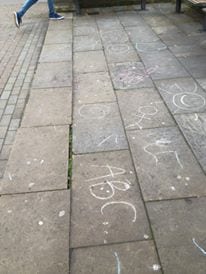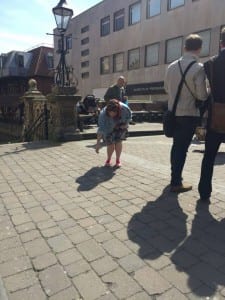FRAMING STATEMENT
Site Specific Explained & Our Performance
Typically, theatre transports the audience to a reality apart from the everyday; [Site Specific] Performance strives to transport everyday reality to something much more. (Cohen-Cruz, 1998, 1)
Site Specific Performance explores the possibility of place and how theatre and performance can be two very separate things. In comparison to theatre, “performance […] requires depth in order to be an event rather than an empty effect.” (Dice Drama Network, Undated) The idea of Site Specific Performance is that of looking into a place or site’s historical, cultural and social factors: where that place ‘starts’ is ultimately up to the artist of the work. Looking practitioners such as Marc Augé, Miwon Kwon, Georges Perec and Cathy Turner, amongst others, we created our piece: High Bridge Histories.
High Bridge Histories was performed on High Bridge in the centre of Lincoln’s busy High Street on Thursday 5th May at 12pm noon. It lasted approximately 12 minutes, with myself, Emma Haigh, Joe Turner and Lucy Workman entering the space at different intervals from different areas of the place. We all had a portable speaker in our hands which played a recording of people that we had taped using a Dictaphone saying lines of speech and conversation that we had overheard around that area over the three months. We also added a number of sound effects that can be typically heard during an average day on High Bridge such as construction work, birds singing and babies crying. Whilst coming into the space at the different intervals, the group and I walked around as naturally as possible whilst doing actions such as drawing in chalk the dates in which we collected the data on the floor and throwing bread crumbs over these dates.
High Bridge is the oldest bridge in the UK and this fascinated our group. The bridge was built around 1160AD and must have been the backdrop of some incredible moments of history; however, its purpose nowadays is to hold the hustle and bustle of Lincoln’s residents and tourists. We decided we wanted our performance to capture how Site Specific Performance often “engenders ideas of place and community” (Wilkie, 2002, 144) to make a non-place become a place using the performativity of everyday life conversations and noises. We wanted to create a soundscape for our audience to be able to witness and listen too, so that they were suddenly aware of themselves in an otherwise transient place, thus creating memorable links and allowing them to become subconsciously spatially aware of the place each time it was either mentioned or they passed through it again in the future. We were particularly interested in Erving Goffman’s idea of everyday behaviour being a spectacle, especially during the beginning of our process. Richard Schechner enforces this idea by stating:
…performing in everyday life uses consciously enacted conventional behaviours [such as] walking down the street in casual conversation with a friend….Everyone masters to some degree or another the social codes of daily life. Rebels intentionally break the rules; revolutionaries want to change them permanently. (2013, 208)
These “social codes” are also known as tacit agreements. These can be challenged discreetly or extremely melodramatically. This was another element to the performance that we wanted to add: making people think about the space they were in and the people in it.
An Analysis of Process
Original Idea – Installation piece – Your Linc!
At the beginning of the module our group were particularly interested in the notion of community. We wanted our performance to reach as many people as possible as it could do within the local area. Whilst looking for locations to perform our piece along the High Street, we noticed that seating areas attracted the most people. We decided that we wanted to create an installation piece created by people of Lincoln. We wanted to be able to challenge Miwon Kwon’s opinion that “‘an artist cannot accurately represent a community and, in attempting to do so, ultimately represents himself and his own work.”(2002) We wanted the community to be able to make the piece as we would not be performing: we would be merely a platform that allowed the public to write whatever they wished. An initial idea was to have a moveable whiteboard with a drawn out map of the city. This board would then have two layers of acetate over the top which acted as physical layers, inspired by Cathy Turner and her idea of palimpsest. Palimpsest is the accumulation of layers, be those socially or historically of a place. The idea of having the different layers of acetate was so that all three types of audience could get involved with the piece, these being: the cyber audience, the unintentional audience and the invited theatre audience. On one piece of acetate, there would be tweets, text messages, emails, Facebook statuses and other forms of technological communication written on there about Lincoln. The next piece of acetate would be the live part of the performance which would allow members of the public to be able to write what they wanted to say about what they thought about Lincoln.
Although we initially liked this idea and the theory surrounding it, we decided that it was maybe too simplistic. We wanted to delve deeper into the sociology that Site Specific Performance allowed us to explore. The group also collectively agreed that the idea that we had initially thought up of sounded more like something that the Lincoln Tourist Board would want to install rather than a drama performance art piece.

Histories of High Bridge
The group and I decided to think more about the topics of authenticity and ownership. We knew that we still wanted to do something that would be in connection with the community of Lincoln. Joe then had the idea to record people’s conversations in a social area which is when we chose High Bridge seating area. The cluster of benches mixed with the busy café opposite posed for the perfect place to begin listening for conversations. For a number of weeks, we listened and overheard many different conversations in that place as well as a number of noises such as cameras clicking, babies crying and birds tweeting. We were able to listen to a number of things: from significant conversations to passing comments to phone conversations that we only heard half of.
We were inspired during the process of this collecting and recording data by Georges Perec. His book An attempt at exhausting a place in Paris (1982) proved to be extremely inspirational to our piece as did his other observations in his collection of stories named Species of Space and Other Pieces. This book contained some interesting exercises which we practised whilst outside in the space. Perec tells us to “Observe the street, from time to time, with some concern for system perhaps. Apply yourself. Take your time.” (1995, 50) We certainly did this and spent five consecutive weeks listening to the street and feeling the space: the general mood of the site, the sounds, and the sights.
We assumed that we were the first people ever to think of this concept; however, we were proved wrong when delving into some more of our own independent research. We discovered that Dee Heddon has also created a similar style text called Going For a Walk: A Verbatim Play. (2015) This play was created by the use of listening to people’s conversations whilst walking. Heddon adds that “This is just one possible story made from the conversations, the story I have chosen to tell (2015, Intro.) She also adds that the intention of the piece is to “…listen out for performances of planning, creativity, commitment and persistence, risk taking, resilience and interdependency, as well as listen in to diverse bodies on the move.” (Heddon, 2015, Intro.) This was ultimately different to ours in the fact that there had been time taken to choose what she wanted the characters to say to make a storyline as opposed to ours where it was random fragments of conversation. Another work that inspired our piece was a collection of short plays written by Craig Taylor called One million tiny plays about Britain. (2009) Similarly to Heddon’s play, it contrasted to ours as the collected speech was deliberately put together in ways so that it made sense and a story was formed. As a group, we decided we did not want our piece to be about stories we had created out of other people’s words, as we felt the High Street as a site represented the realities of Lincoln as a city; we wanted to do justice to this through keeping people’s words as their own without altering them.
The idea of looking at how people ‘performed’ during everyday life was incredibly interesting and something that was central to the point of our new performance. We wanted to show the beauty of mundane activities and conversations in a space we came to understand to be a ‘non-place.’ The idea of place and non-place was introduced by Marc Augé. ‘Non-space’ is the idea that places could be transient; anywhere where people merely pass through or have no real interaction with anyone is a non-place, whereas a place would be somewhere where people had communication, meaningful conversation and stayed where they were. Of course, there are flaws with this system: what about a homeless person? Surely a place for them would be the High Street as that would be their home in comparison to me where it is somewhere where I just walk through daily to get to my destination. We wanted to make sure that people were aware of the place they were in, to show that anywhere could be a ‘place’ and demonstrate the repetitive nature of life that occurred there. Sue Palmer was an advocate in our way of thinking as she states that “it’s not just about a place, but the people who normally inhabit and use that place. For it wouldn’t exist without them.” (Pearson et al, 2010, 8)
We still wanted to adhere to Cathy Turner’s idea of palimpsest whilst still using conversations and communication as the main focus. We decided to get strangers, friends and family to record the snippets of conversation that we had heard and then Lucy arranged them in a stylised audio file. The idea was that we were to play these recordings over the top of us speaking, similar to Forced Entertainments’ piece, Speak Bitterness (1994), where actors speak people’s confessions at a table over 6 hours. Having the recording and our voices would therefore create a number of layers: a live layer, a recorded layer and the layer of the original conversations that we wrote down.
“Language and media seem natural partners and enemies. My interest is in their co-existence, their frictions and the humans caught in between.” (Kaye et al, 2007, 163)
Upon feedback we received, we realised that the first audio file sounded very polished and some of the voices sounded quite rehearsed and acted. The idea of our performance was that the words were meant to be said as they were heard, completely natural and not out of place. We then took the track and listened to all of it, picking out the most natural sounding recordings and Lucy then placed them into a new sound file which we then used instead.

After receiving some feedback about the visual aesthetics of our piece, we added certain other layers to the piece such as drawing chalk pictures on the floor,(see fig. 1) throwing bread for the birds and using props such as baby bottles and rattles. This was meant to be an added layer for the palimpsest of the piece; however, we were told that it was too acted and less performative. We decided to cut back on the actions. Instead, we decided to write down on the floor in chalk the dates on which we collected material as well as putting bread crumbs for the birds on top of the dates we wrote. We then proceeded to clean up the dates using a scrubbing brush. When the phone ringtones rang, we gave out business cards with this blog’s web address on it (see fig. 2) This idea was so that members of the unintentional audience could then look at what we had done and then possibly share the page through interest therefore creating a cyber-audience and thus more layers.
Instead of too many physical actions, we decided on looking into depth at John Smith’s A Girl Chewing Gum. This was a piece that was shown to us by our lecturer and was very appealing to our piece. It showed an everyday scene that was then narrated over the top of to look like life was played by stage directions. We took this idea and incorporated it into our own work, deciding on instead of having predetermined speech with mime, as well as having the recordings blaring out, we would also speak in the same manor that Smith did during his piece henceforth adding another palimpsest layer to the performance.
Performance Evaluation
As if we weren’t nervous enough on our performance day, to add to the stress a busker had decided to set up right in the middle of our space. Thankfully with some gentle persuasion he decided to stop playing for us during the performance. This was just another unpredictability of working in a public site which was something that we had prepared for in advance.
As the performance was staggered, it was difficult to see how everyone else worked in the space. I feel that I did my part reasonably well and as I was the third person to enter the space I was pleasantly surprised that we had accumulated an audience of onlookers from both the street and the neighbouring shops and cafes. With all of these unfamiliar and some familiar faces watching, it was difficult not to fall into old habits of becoming a character rather than just merely performing as oneself. Instead of acting, we had “…to focus on accomplishing the set task…” (Shechner, 2013, 208) which was both challenging but fun. (See Fig. 3)
We were able to achieve a sense of ephemerality in our piece, as it was only ten minutes long, showing the pace of life and how people don’t stop to appreciate their surroundings. We wanted to merge the past and present together and I think our physical actions and the verbal sounds worked well to show this because we had audience members speak to us at the end knowingly understanding what our piece was about which was a pleasant surprise that our intentions had been so clear. Maybe if I had to improve the piece, it would be to stylize the movements slightly more as I think we looked so random, it didn’t look naturalistic as we wanted it to.
Not working within the theatre has been a challenge for me. Being told not to act but to perform was a complete shock and something that I weekly had to work on. As a naturally melodramatic person, being advised to act ‘natural’ was something I found particularly challenging as my acting natural is something completely different to someone else’s. Although this module has been filled with ups and downs, I am proud of my achievements as both ensemble member and as development for my own acting abilities. It has opened up a field in which I would never usually want to peruse or look into but I am happy that I have had the opportunity.

WORD COUNT: 2560
Works Cited
Cohen-Cruz, J. (1998). Radical street performance. London: Routledge.
Dramanetwork.eu. (2016). Drama Improves Lisbon Key Competences in Education -. [online] Available at: http://www.dramanetwork.eu/educational_drama.html [Accessed 8 May 2016].
Heddon, D. (2015). Going for a walk: a verbatim play. Studies in Theatre and Performance, 35(3), pp.177-188.
Kaye, N. (2007). Multi-media. New York: Routledge.
Kwon, M. (2002) One place after another, Site specifc art and locational identity. MIT Press: Massachusetts.
Pearson, M. (2010) Site- Specific Performance. Palgrave Macmillan: Basingstoke
Perec, G. and Sturrock, J. (1997). Species of spaces and other pieces. London, England: Penguin Books.
Schechner, R. (2013). Performance studies: An Introduction. Third Ed. London: Routledge.
Wilkie, F. (2002) Mapping the Terrain: A Survey of Site-Specific Performance in Britain. New Theatre Quarterly. 18 (2) 140 – 161.
Leave a comment